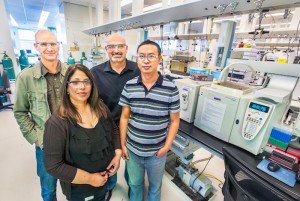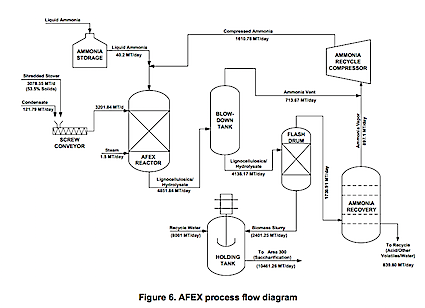Why we have a Joint BioEnergy Institute: the story of ionic liquids
It’s been the big, big problem in biomass deconstruction and cellulosic fuels — the finicky nature of biomass. We’ve learned to get past the main line of cellulosic defenses — but by and large it’s been a feedstock-by-feedstock, multi-step process, not well suited for competing with $60 oil when the biomass cost itself has risen by DOE’s estimate to $115 per ton.
Pre-treatment cost has been one factor; more importantly, getting a consistent product stream out of a variable set of biomass inputs. No two feedstocks are alike, and sometimes no two deliveries of the same feedstocks are much alike. Consider the variability in municipal solid waste, for example.
Pre-treatment is expensive. In fact, a 2010 NREL study found that the capital cost of pre-treatment systems was higher than either Saccharification & Fermentation, Distillation and Solids Recovery, or feedstock handling. In fact, it’s the second-highest cost area, after the boiler.
A revolution in deconstruction was not the sole reason the JBEI was founded several years ago; there’s whole lotta shakin’ going’ on there, on a wide front of topics. But its work in developing a solution to, ahem, a Big Problem in Biomass, gives a good demonstration as to why DOE created these institutes in the first place,
You see, JBEI’s team believe they have come up with the solution in a new generation of ionic liquids.
What are ionic liquids, anyway?
They are environmentally benign organic salts. In this case, salts that are liquids rather than crystals at room temperatures – and they possess a unique capacity for dissolving lignocellulosic biomass and helping to hydrolyze the resulting liquor into sugars.
Back in 2009, Alexis Bell and a team at Berkeley Lab worked with the ionic liquid 1-butyl-3-methylimidazolium chloride or [BMIM][Cl], Bell and his group found that even at the boiling point of water – 100 degrees Celsius – the BMIM][Cl] will dissolve cellulose sugars without inducing any structural changes to the sugars. Bell and his team also found that temperatures could climb as high as 120 degrees Celsius before serious degradation of the cellulose structure occurs.

From left, John Gladden, Seema Singh, Blake Simmons and Jian Shi led the development at JBEI of a one-pot system for the ionic liquid pretreatment and saccharification of switchgrass for biofuel production. (Photo by Roy Kaltschmidt)
“Imidazolium is the most effective known ionic liquid for breaking down cellulosic biomass for enzymatic hydrolysis into fermentable sugars,” reflected JBEI’s Director of Biomass Pretreatment, Seema Singh. “However, imidazolium, like other ionic liquids, can inhibit the commercial enzyme cocktails now used for the saccharification of cellulosic biomass and must therefore be removed by substantial amounts of water after the pretreatment. The recycling and waste disposal costs associated with this required washing pose a significant challenge for the commercial scale-up of ionic liquid pretreatment technology.”
“By combining ionic liquid pretreatment and saccharification into a single vessel,” said JBEI’s head of deconstruction, Blake Simmons, “we drastically simplify the downstream sugar/lignin recovery process and enable the ionic liquid to be recycled; all factors that help drive down biofuel production costs.”
Simmons told The Digest that it is for this reason that “Harvey Blanch and myself started focusing on ionic liquids almost from the first meeting we had as JBEI got underway.”
So, we’ve defined the problem. What’s the solution? A “one-pot” wash-free process for the ionic liquid pretreatment and saccharification that can, essentially, dissolve any biomass cellulosic feedstock — and generate a consistent product that is readily converted into fermentable sugars suitable for the production of advanced biofuels.
The challenge, historically, is that the teams that work on pre-treatment, on organism development, and on downstream processes with enzymes worked in different regimes, on different timelines, with different goals.
So, you could get a great pre-treatment result, seen in isolation, and then find that you killed the enzymes down the line.
Enter JBEI, with its multi-disciplinary approach
For one, JBEI researchers in the fungal biotechnology area, led by John Gladden, developed a compost-derived consortium of bacterium adapted to grow on switchgrass. They dubbed this consortium “Jtherm,” and it consists of several species of thermophiles, microbes that thrive at extremely high temperatures and alkaline conditions.
“Jtherm is both an ionic liquid and heat tolerant cellulase cocktail that can liberate sugars from biomass in the presence of up to 20-percent ionic liquids,” Gladden says.
Now, back to the deconstruction team, led by Singh and Simmons. They tested Jtherm for the saccharification of switchgrass following an imidazolium-based ionic liquid pretreatment. With this one-pot system, by mid-2013 they liberated 81.2-percent glucose and 87.4-percent xylose over the course of a 72 hour processing at 70 degrees Celsius. They were then able to separate the sugars at better than 90-percent efficiency.
“Our results were very close to the 85-to-95-percent sugar yields that are typically achieved with separate pretreatment and saccharification processing steps,” says Simmons. “Further improvements must be realized, primarily in the composition and activity of the enzyme cocktails used, in order to reach our target yields of better than 95-percent for all fermentable sugars.”
Work has continued at a high pace. Last year, a review of the efficacy of four cholinium and imidazolium ionic liquids appeared in Green Chemistry, penned by the JBEI team.
The multi-team, multi-disciplinary approach pays off in other ways. For example, in 2011, a team of JBEI researchers demonstrated that introducing a corn gene into switchgrass increased the amount of starch in the plant’s cell walls by 250 percent, and made it much easier to extract polysaccharides and convert them into fermentable sugars. The gene, a variant of the maize gene known as Corngrass1 (Cg1), holds the switchgrass in the juvenile phase of development, preventing it from advancing to the adult phase.
“We show that Cg1 switchgrass biomass is easier for enzymes to break down and also releases more glucose during saccharification,” Simmons noted. “Cg1 switchgrass contains decreased amounts of lignin and increased levels of glucose and other sugars compared with wild switchgrass, which enhances the plant’s potential as a feedstock for advanced biofuels.”

A traditional (AFEX, in this example) pre-treatment system can cost up to $36M in a cellulosic biofuels commercial-scale facility, according to NREL.
From ionic to bionic
Now, ionic liquids such as imidazolium are traditionally made from fossil fuels — why not undertake an effort to make them from biomass itself?
“Imidazolium-based ionic liquids effectively and efficiently dissolve biomass, and represent a remarkable platform for biomass pretreatment, but imidazolium cations are expensive and thus limited in their large-scale industrial deployment,” Singh told phys.org last year. “To replace them with a renewable product, we synthesized a series of tertiary amine-based ionic liquids from aromatic aldehydes in lignin and hemicellulose.”
The JBEI team tested the liquids on switchgrass. After 73 hours — they liberated 90-95 percent for glucose and 70-75 percent for xylose over the course of a 72 hour processing at 70 degrees Celsius. They were then able to separate the sugars at better than 90-percent efficiency.
Not to mention, finding a very good use for abundant lignin.
Can microbes survive ionic liquids?
Again, there’s the problem of microbes surviving the ionic liquids in a wash-free, one-pot system. These are tough salts to survive.
“The extensive washing required for complete ionic liquid removal is not feasible in large-scale, industrial applications,” Simmons said. “An ideal and more sustainable process is to balance the costs of removing the ionic liquid with the fermentation performance by using biofuel-producing microbes that can tolerate residual levels of ionic liquids.”
But another JBEI team identified the genetic origins of a microbial resistance to ionic liquids and successfully introduced this resistance into a strain of E. coli bacteria for the production of advanced biofuels. The ionic liquid resistance is based on a pair of genes discovered in a bacterium native to the El Yunque National Forest in Puerto Rico.
“We identified two genes in Enterobacter lignolyticus, a soil bacterium that is tolerant to imidazolium-based ionic liquids, and transferred them as part of a genetic module into an E.coli biofuel host,” says Michael Thelen, a biochemist with JBEI’s Deconstruction Division. “The genetic module conferred the tolerance needed for the E.coli to grow well in the presence of toxic concentrations of ionic liquids. As a result, production of a terpene-based biofuel was enhanced.”
The testing through pilot-scale
So, it works in a lab, what about at pilot-scale?
To expedite commercialization of its research breakthroughs, JBEI conducts feasibility and scale-up tests using the facilities at LBNL’s Advanced Biofuels Process Demonstration Unit, located in Emeryville. ABPDU provided the industry-scale test beds for both JBEI’s work on ionic liquid pretreatment and microbial synthesis of bisabolene, a terpene-based precursor to an advanced biofuel that potentially could replace diesel.
In a study assessing the optimization and scaling potential of ionic liquid pretreatment, JBEI and ABPDU scientists and engineers determined that this technology can be effectively scaled to larger biorefinery operations. In addition, unit operations and process parameters obtained in the study will be essential for analyzing the technoeconomic aspects of this technology. The JBEI-ABPDU collaboration is the first of its kind in the research community, successfully identifying key opportunities and challenges associated with ionic liquid pretreatment and subsequent enzymatic saccharification beyond the bench scale.
The bottom line
Pre-treatment has been a major stumbling block — not the least because previous efforts to improve pre-treatment were not multi-disciplinary in nature. JBEI and the other bioenergy centers (the BioEnergy Research Center led by Oak Ridge, and the Great Lakes Bioenergy Research Center, led by the University of Wisconsin-Madison, with Michigan State University as a major partner), all have the multi-disciplinary approach, and the bioenergy focus, to achieve something like the work to date on ionic liquids.
JBEI’s partner institutions are: Lawrence Berkeley National Laboratory (lead institution): Sandia National Laboratories, Pacific Northwest National Laboratory, Lawrence Livermore National Laboratory, University of California–Berkeley, University of California–Davis and the Carnegie Institution for Science.
